Recent Articles
Popular Makes
Body Types
2015 Ford F-150 Full-Size Pickup First Drive and Review
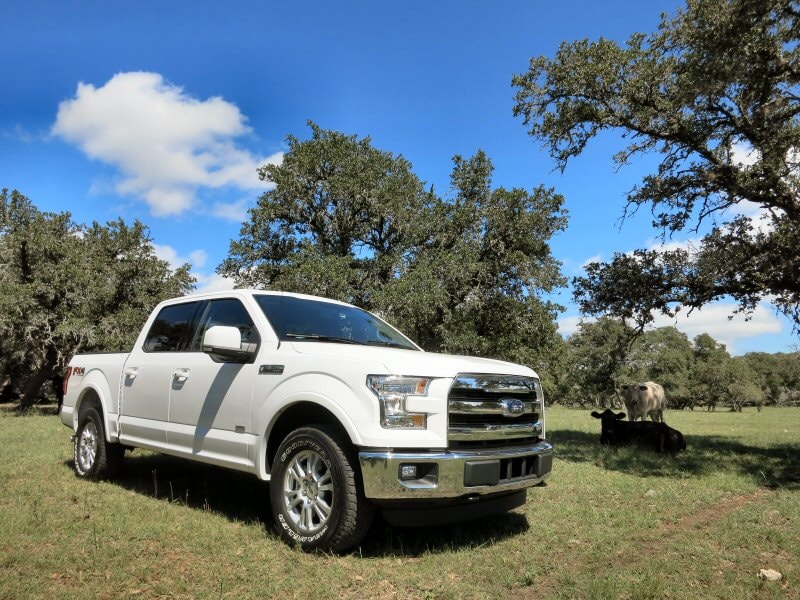
2015 Ford F-150
The 2015 Ford F-150 is kind of a big deal, and for more than one reason. Any time America's best-selling vehicle is completely redesigned is cause for cautious celebration, because this full-size truck has morphed into a national icon, and no one wants to see a hero of this stature stumble. The collective holding of breath associated with this latest 2015 iteration of the truck has been even more pronounced due to Ford's decision to deploy the first all-aluminum pickup body on the market, a daring move intended to introduce significant weight savings, improve performance, and enhance efficiency.
Sometimes what sounds like a revolution turns out to be more of an evolution, however. After driving the 2015 Ford F-150 in and around San Antonio, Texas, and sampling its capabilities both on and off road, it’s easy to see that the new pickup has been improved in several key areas. At the same time, it feels like there's less of a gap between the F-Series of old and its latest incarnation. It's a great truck, made better, in a world where great trucks are fast becoming the norm.
All About Aluminum
Ford has placed a huge emphasis on the use of aluminum to craft the 2015 Ford F-150's body panels, and with good reason, as the decision has seen between 500 and 700 lbs of curb weight sliced from the pickup (depending on the model). In development since 2009, when the aluminum strategy was initially announced last year there was skepticism from truck buyers and media types concerning the durability of the lighter metal in the hostile work environments where pickups often pull duty - specifically, regarding the ability of aluminum to resist dents and punctures. Additional concern about the cost of repair of the harder-to-work-with material was also voiced, leading to speculation that insurance rates and body shop prices could rise for this new generation of F-150 models.
Ford's answer was to reveal that it had secretly tested several aluminum truck beds long-term with a few mining and construction clients on their fleet-spec pickups in order to gather real world data regarding corrosion and resistance to impact damage. Satisfied with the results, the Blue Oval then moved to invest significant dollars in retraining its service center technicians in working with the aluminum alloy used on the F-150 so that when the trucks hit the market (predicted to be before the end of this year) there wouldn't be any lag time at the body shop.
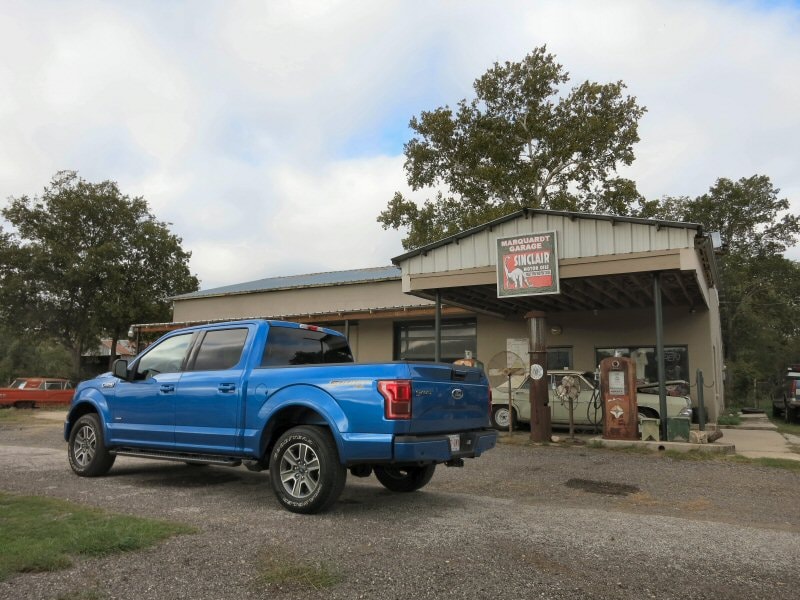
Photo by Benjamin Hunting
Doing More With Less
Underneath the 2015 Ford F-150's new aluminum skin - which features broader styling up front, new LED headlights, and a creased tailgate reminiscent of the recently refreshed Super Duty series of trucks - there's still a high strength steel frame shouldering most of the workload. The F-150 sees payload and towing capacity increases across the board, thanks in large part to the reduction in the overall mass of the truck making more of its gross vehicle weight rating available for use by owners. Maximum trailering now checks in at 12,200 lbs, which is a 1,100 lb increase compared to the previous generation of the truck, and you can carry up to 3,300 lbs in the bed of the F-150 (a 530 lb jump).
Naturally, those gains are realized when ordering the 2015 F-150 with its most powerful engine, the same 3.5-liter EcoBoost V-6 that was available last year. With the absence of the Raptor and its 6.2-liter V-8 from the new F-Series line-up, the 365 horses and 420 lb-ft of torque offered by the twin-turbo unit make it the undisputed king of the hill in Ford country, although the truck's available 5.0-liter V-8 isn't far behind (385 horsepower, 387 lb-ft of torque). What the eight-cylinder doesn’t have over the EcoBoost mill is efficiency: official numbers won't be out until November, but look for the V-6 to continue to provide the same efficiency gap over the 5.0 that it did last year.
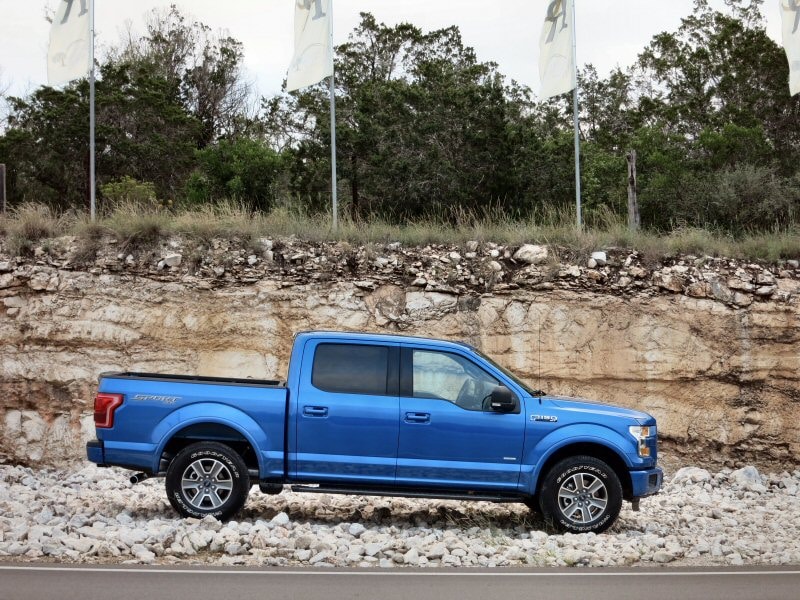
Photo by Benjamin Hunting
Boosting Performance And Efficiency
The 3.5-liter EcoBoost V-6 won't just be better than the 5.0-liter V-8 for 2015, but it's also likely to be more frugal compared to the 2014 truck - as will every engine in the F-150 portfolio - thanks to the aluminum diet. With less truck to move from point A to point B, Ford was also able to downsize the F-150's entry-level, naturally-aspirated V-6 from 3.7 to 3.5-liters, sliding output from 302 horses to 283 and torque from 278 lb-ft to 255 lb-ft without an appreciable loss in performance. The company claims that the best balance between power and efficiency will actually be found with the all-new 2.7-liter EcoBoost V-6. The twin-turbo design pushes out 325 horsepower and 375 lb-ft of torque, and comes with an 8,500 lb tow rating of its own. Ford hopes to entice early adopters by making the 2.7-liter a mere $495 option over the base V-6 for an undisclosed 'introductory period.'
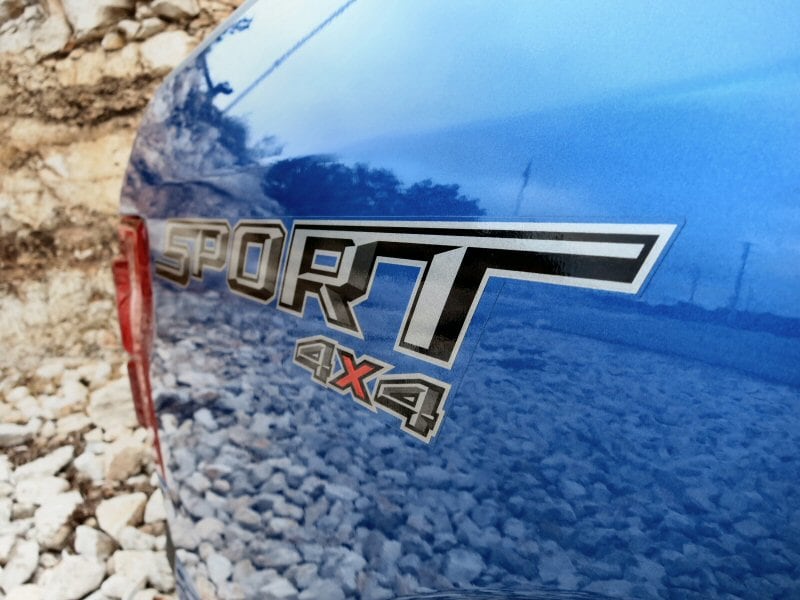
Photo by Benjamin Hunting
Real World Benefits
That's certainly an investment I would make at buying time. I had a hard time believing that a modern truck was now offering a twin-turbo engine design identical in size to that which had once powered the Audi S4 sport sedan a mere 15 years ago, but there it was, sitting just ahead of me under the hood of the 2015 Ford F-150 and responding with enthusiasm to inputs from my right foot on the truck's go-pedal. There's no doubt that the smaller member of the six-cylinder EcoBoost family is up to the task of daily driving in the pickup, and I found it to offer respectable acceleration on the highway and around town during my 100 miles or so of testing.
Was it any better than the larger, 3.5-liter EcoBoost when it came to fuel mileage? According to the F-150's on-board displays, not really. The more potent twin-turbo V-6 showed 19-mpg in mixed driving, only one mile per gallon less than the 2.7-liter, and while my first-hand experience with the two engines could hardly be called definitive from a fuel consumption perspective, neither myself nor my co-driver were babying either motor.
The difference in weight between the 2015 and 2014 editions of the Ford pickup were much easier to quantify, especially when pulling out to pass or leaving the line hard. A six-speed automatic transmission remains standard with the truck, and it boasts a new Sport mode that helps keep the revs up when driving in a more spirited manner . The new F-150 felt more spry and athletic under hard acceleration, and handling was also smoother through a tight autocross course than one would expect from such a large vehicle. You still notice the bumps and bruises in the pavement with the revised Ford chassis, and the live rear axle wasn't as controlled by the pickup's rear leaf springs as it is in the Ram 1500 with its coil spring setup, but road noise has been reduced for each model. Climbing rocky trails and blasting across muddy creeks in the 2015 F-150 revealed the strengths of its FX4 off-road package, which for the first time becomes available with any trim level of the truck.
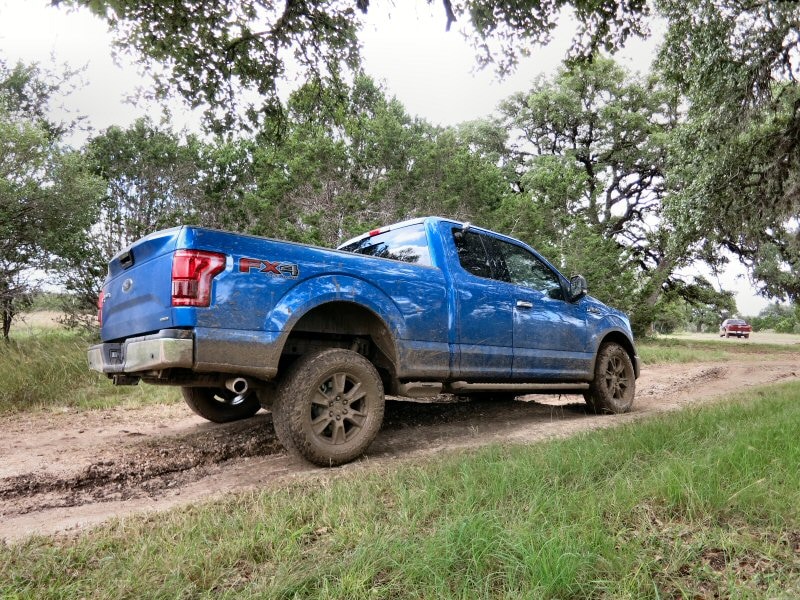
Photo by Benjamin Hunting
The More Things Change…
Ford has crammed a bunch of new features into the 2015 F-150, and these can be divided into improvements to existing gear or high tech/luxury-oriented features that weren't previous available. Equipment that has seen its functionality enhanced with the redesign include the tailgate step, tailgate lock (which can now be remotely secured and released), side-step at the front of the box, exterior lighting (LEDs available 360-degrees around the truck), and the sunroof (now panoramic). New gee-whiz items abound, such as massaging front seats, a trailer-hitch camera that makes it easier to line-up your ball-and-socket, a top-down camera view useful when parking, adaptive cruise control, a ramp system for loading bikes and ATVs into the cargo bed, inflatable rear seatbelts, retractable running boards, and a new cargo management system.
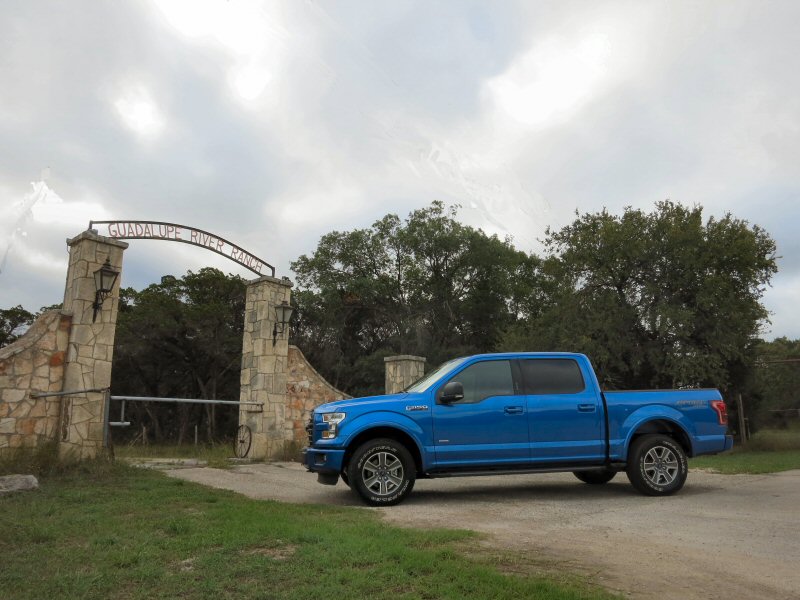
Photo by Benjamin Hunting
…The More They Stay The Same
The 2015 Ford F-150's cabin, despite the heaps of fresh entries on its options list, looks largely the same as it was the year before despite a bump in pricing (the truck starts at $26,615 for base XL models, and rises to $52,155 for Platinum editions, including delivery). The addition of dials and knobs to the truck's MyFord Touch system will come as a relief to anyone who regularly wears gloves while driving, and the center console is now more widely available (and deeper) and sports a very thick shift lever. Aside from those details, it's a largely familiar setup on the dashboard and gauge cluster, which is certainly no knock against the F-150, but it feels like a bit of a missed opportunity to really wow potential buyers with design and materials.
The truck's SuperCab (read: extended cab) body style is more of an issue. Ford has elected to keep the rear-hinged doors that were used on the 2014 F-150, which means that rear passengers cannot exit the vehicle unless the front rider opens their door first. At the very least, Ford has improved the rear hinge so that the door now opens 170 degrees - previous versions weren't nearly as versatile and had the bad habit of fencing you in against the vehicle parked beside you with both doors open. In a segment where all other major competitors feature traditional front-hinged, four-door setups, the F-150 is lagging behind, and I recommend the SuperCrew model's easier-to-use setup over the SuperCab for this reason.
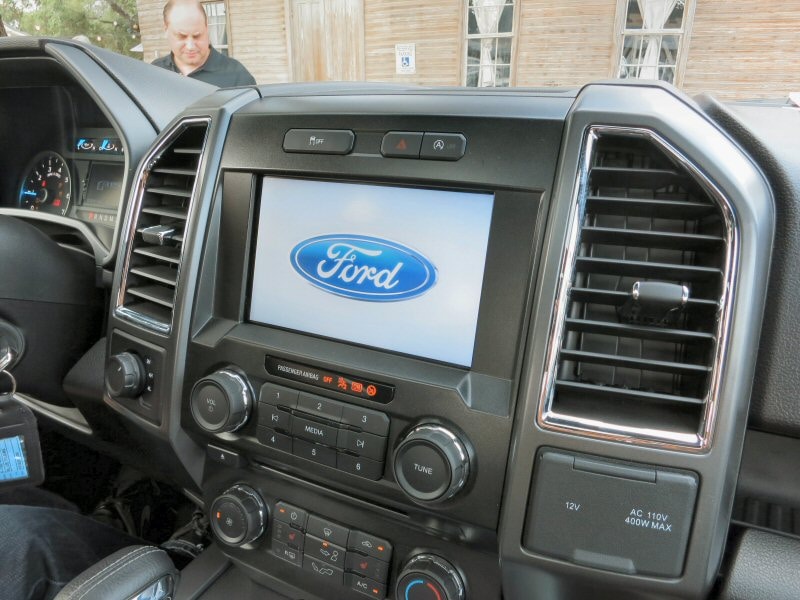
Photo by Benjamin Hunting
A Great Truck, Redux
The clear dominance that the F-Series has enjoyed over its rivals in recent decades has narrowed. This is great news for truck buyers, because there are now so many strong options available, and more importantly, different takes on what a full-size truck should bring to the table. With near-parity in the performance department at hand amongst pickups, choosing the vehicle that fits your lifestyle and budget becomes more important than crunching raw towing and hauling numbers.
The 2015 Ford F-150 is an excellent full-size truck, and it's one that will certainly satisfy existing customers. It might even pry away a few Tundra owners tired of Toyota's decision to tread water with the latest generation model. It's hard to say, however, whether the all-new F-150 will snag Chevy, GMC, or Ram drivers in significant numbers. I particularly liked the new 2.7-liter EcoBoost engine, I am sure that EPA fuel mileage figures will be better than they were the year before for every motor, and I applaud the decision to lead the industry and move forward with an aluminum body structure. That being said, the F-150 isn't the final word it once was, and you owe it to yourself to drive each of the major players out there before deciding which pickup is right for you.
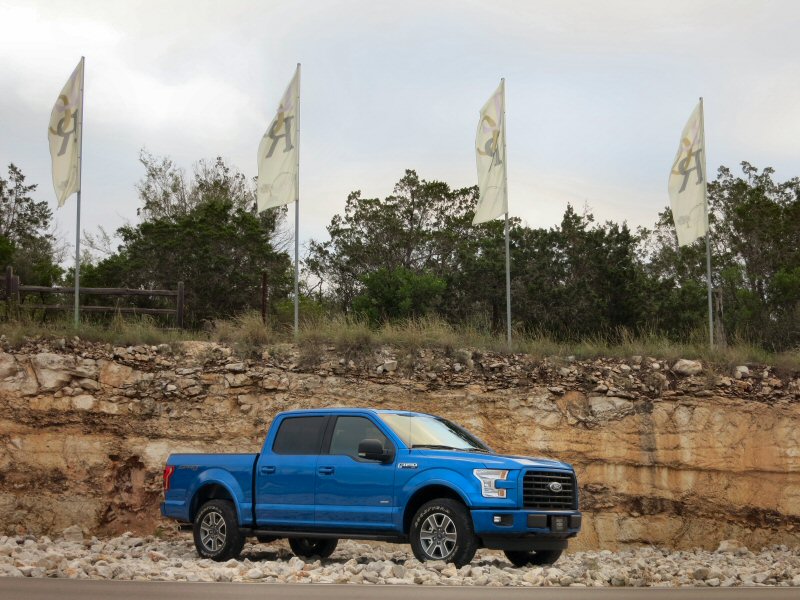
Photo by Benjamin Hunting